A project replacing coastal pines with native coastal forests was run by Tāne’s Tree Trust and supported by us to the tune of $2500 per year for three years as well as in-kind support. This project was funded by the Ministry of Primary Industry’s Sustainable Farming Fund. It received advice, labour and funding from TTT’s many council, forestry, iwi and community project partners.
The five reports that resulted from this project are available on Tane’s Tree Trust website and on our database.
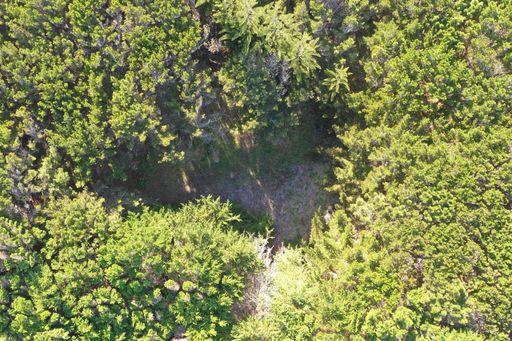 An example of a canopy gap within the pine buffer where natives have been planted to compare with planting under the surrounding dense canopy in the Te Hiku trialsUpdate May 2021
An example of a canopy gap within the pine buffer where natives have been planted to compare with planting under the surrounding dense canopy in the Te Hiku trialsUpdate May 2021
Sand dune exotic forests typically have a sacrificial exotic forest buffer zone providing critical salt and wind shelter to production stands landward.
The Tāne’s Tree Trust Coastal Buffers project, in collaboration with the Coastal Restoration Trust, Waikato Regional Council, Northland Regional Council, and local forestry companies, iwi and Coastcare groups, focuses on the upper North Island as a pilot study exploring practical options to transition failing exotic buffers to resilient permanent indigenous coastal forest buffers. To date the project has undertaken a review of existing experience, field surveys around upper North Island duneland and established two planting trials in collaboration with forestry managers, iwi, landowners, councils and communities.
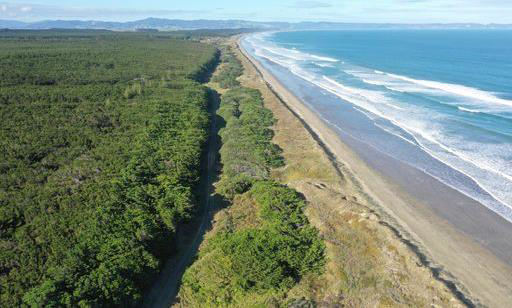 The buffer of pohutukawa planted by the NZ Forest Service 40 years ago at Te Hiku warrants further investigation to determine practical establishment methods for extending native forest buffers to other coastal sitesWe are now planting our third and last field trials and preparing to develop preliminary guidelines for transitioning exotic coastal dune buffers to indigenous buffers based on the project’s findings.
The buffer of pohutukawa planted by the NZ Forest Service 40 years ago at Te Hiku warrants further investigation to determine practical establishment methods for extending native forest buffers to other coastal sitesWe are now planting our third and last field trials and preparing to develop preliminary guidelines for transitioning exotic coastal dune buffers to indigenous buffers based on the project’s findings.
The key objective is to determine a suite of cost-effective methods for conversion of the exotic dominated coastal buffer to natives. This is likely to comprise a number of approaches where the aim is to assist natural succession wherever possible.
Te Hiku Forest (Summit Forests Ltd - Far North)
 A 2020 planted tawapou under pine canopy (left); karaka showing browse on middle plant in the 2020 seed trial. Te HikuThe initial 2019 trials at Te Hiku were severely hit by the 2019-2020 drought. The low survival rate made it hard to draw any definite conclusions, but indications are that there may be a beneficial effect from the pine buffer canopy. Browse from horses and rabbits/hares was more frequent in the open coast sites compared with the pine gap and canopy sites. Pohutukawa did not show any pressure from browse but there was heavy loss due to low soil moisture.
A 2020 planted tawapou under pine canopy (left); karaka showing browse on middle plant in the 2020 seed trial. Te HikuThe initial 2019 trials at Te Hiku were severely hit by the 2019-2020 drought. The low survival rate made it hard to draw any definite conclusions, but indications are that there may be a beneficial effect from the pine buffer canopy. Browse from horses and rabbits/hares was more frequent in the open coast sites compared with the pine gap and canopy sites. Pohutukawa did not show any pressure from browse but there was heavy loss due to low soil moisture.
Survival within the 2020 trial plantings was however much higher reflecting a better summer without a severe drought. Initial results nevertheless showed an increase in survival and plant vigour where pine canopy provides shelter.
The last 2021 trials are about to be planted to continue testing the survival of different shrub and tree species in open, shelter pine gaps and under pine canopy situations. This year the trials include taupata, karamu, akeake, mingimingi, wharangi, ngaio, mapou, harakeke, titoki, taraire, karaka, kohekohe, porokaiwhiri/pigeonwood, lacebark, tawapou, totara and pūriri.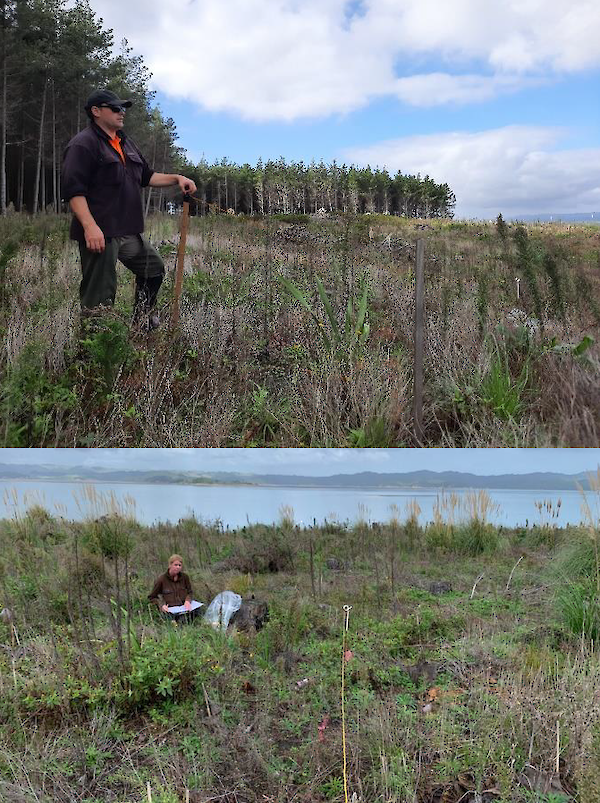 Planting site one year after planting the Takapuwahia trial in 2020 showing typical weed growth, Kāwhia Harbour
Planting site one year after planting the Takapuwahia trial in 2020 showing typical weed growth, Kāwhia Harbour
Seed trials are also being repeated for a selection of large-seeded plants (karaka, pūriri, kohekohe, porokaiwhiri/pigeonwood and tawapou). So far, the seed trials are showing success with karaka however there are large losses due to rabbit or hare browse. The few taraire seedlings found in the seed plots had died from lack of water. No kohekohe or pūriri were found to have germinated and it is unclear whether their germination may be delayed or affected by moisture content.
Further evaluation of the buffer of pohutukawa planted seaward of the exotic buffer by the NZ Forest Service in the late 70s and early 80s will be undertaken to provide further insights, methods of establishment and early management.
Kāwhia Forest
Reassessment of the initial 2019 plant trial found similar plant losses with the extreme summer drought. Another finding from the plastic plant protector treatment (to avoid animal browse) was the unintended consequence of overheating some plants during the summer. Unfortunately, cattle had gained access to the trial plantings within the first year of planting with significant browsing of planted natives particularly in the lower zone.
There were indications that the natives planted in close proximity to shelter and shade provided by the northern slope of pine trees had higher survival rates. Similarly, there appeared to be higher survival rates for plants where there was extra shelter at a microsite level from slash piles, dead pampas or lupin.
 Kanuka planted with a jute plant guard (left) and totara with a coir plant guard (right). Both biodegradable plant protectors were collapsing with potential to suppress smaller seedlingsDuring 2020 a further 4,000 plants were planted, 800 of which were incorporated into the 2019 trial site and the balance in the 2020 Takapuwahia site trials. This site is a relatively flat backdune bordering the northern edge of the Kawhia Harbour with slash typical of pine cutover with scattered regrowth of mostly exotics including lupin, inkweed and pampas, and occasional wilding pine seedlings emerging. The Takapuwahi trial incorporated two treatments (standard and deep planting; and with and without biodegradable plant protectors) and included totara, manuka, kanuka, ngaio, harakeke and ti kouka.
Kanuka planted with a jute plant guard (left) and totara with a coir plant guard (right). Both biodegradable plant protectors were collapsing with potential to suppress smaller seedlingsDuring 2020 a further 4,000 plants were planted, 800 of which were incorporated into the 2019 trial site and the balance in the 2020 Takapuwahia site trials. This site is a relatively flat backdune bordering the northern edge of the Kawhia Harbour with slash typical of pine cutover with scattered regrowth of mostly exotics including lupin, inkweed and pampas, and occasional wilding pine seedlings emerging. The Takapuwahi trial incorporated two treatments (standard and deep planting; and with and without biodegradable plant protectors) and included totara, manuka, kanuka, ngaio, harakeke and ti kouka.
The trial was fully remeasured in May 2021. While data has yet to be analysed, preliminary observation indicate overall survival is over 80%. Best survival and plant vigour were for planted kanuka and ngaio, with at least half the totara performing well, and poorer suvival for manuka and ti kouka, the latter clearly affected by rabbit browse. Plant protectors appeared not to have a significant difference with both the jute and coir types collapsing sometimes over the planted  2020 pine canopy plots showing good survival a year later, Opoutereseedlings. Deeper planted seedlings appeared to have higher vigour compared to standard depth plots however survival appeared to be fairly similar.
2020 pine canopy plots showing good survival a year later, Opoutereseedlings. Deeper planted seedlings appeared to have higher vigour compared to standard depth plots however survival appeared to be fairly similar.
Regrowth of weeds species included pampas, blackberry, ginger, gorse, wilding pine and inkweed with some seedling requiring releasing. Native regeneration included pohuehue and Carex testacea.
The last 2021 trials at Kāwhia have been planted out at the main ocean beach (in behind frontal dune within pampas, mid dune swales with pine slash and weeds, and further inland within the replanted pine buffer. Over 20 different native tree and shrub species are being trialed. A block of totara has also been inter-planted with kanuka and manuka as a nurse at the Takapuwahia site.
Opoutere forest
Reassessment of the initial 2019 plant trial found the plantings were significantly affected by the extended 2019-2020 drought. Some species were also affected by rabbit browsing. There were clear results for which species could survive planted out in the open and despite the summer drought, e.g. karo, akeake. Results from plants with some shelter from pines showed indications that a few canopy species could establish. However firm conclusions could not be drawn due to the high mortality rate exacerbated by the drought.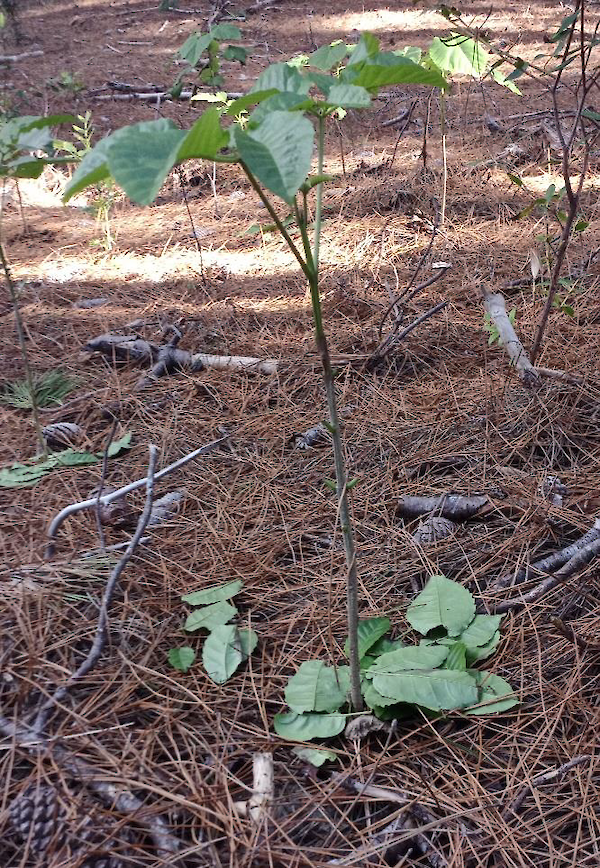 A pūriri with browsed lower leaves showing the benefit of using taller plants where browsing is an issue, Opoutere
A pūriri with browsed lower leaves showing the benefit of using taller plants where browsing is an issue, Opoutere
In 2020 a further 3,455 plants were planted. This included the establishment of new trials under pine canopy and in a clearing surrounded by pine forest. The new trial sites included 9 different tree species. The results from the resurvey of these 2020 trials has yet to be fully analysed but indications are that karaka, kohekohe, pūriri, whau and titoki have so far performed the best, particularly under the pine canopy. Rabbit or hare browse was an issue for some species including karaka and karo while pōhutukawa and titoki were affected by insect damage. Totara had mixed survival results with a lot of die-back and kanuka was the worst performer with generally low survival.
The mass planting of karo in 2020 out on the open coast showed good results and indicated this species will be key for establishing initial shelter out on open exposed sites.
The last 2021 trials at Opoutere are about to be planted and will be similar to the 2020 planting with trials under pine canopy and in a clearing surrounded by pine forest.
Support for this Tāne’s Tree Trust project was gratefully received from project partners including the Sustainable Farming Fund, Summit Forests, Northland Regional Council, Far North iwi, Kaitaia Intermediate, Waikato Regional Council, Kāwhia-Tainui Inc, Kawhia community volunteers, Department of Conservation Hauraki, Ngāti Tara Tokanui, Opoutere community volunteers, Hancock Forest Management (NZ) and the Coastal Restoration Trust.
Update October 2020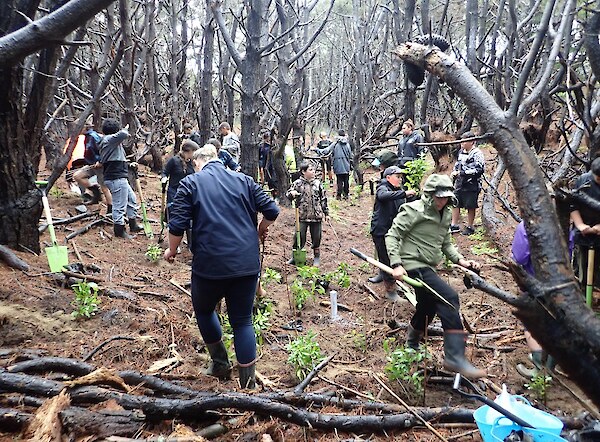 Kaitaia Intermediate School children planting a southern (T4) sheltered pine canopy trial plot, Te Hiku
Kaitaia Intermediate School children planting a southern (T4) sheltered pine canopy trial plot, Te Hiku
Sand dune exotic forests typically have a sacrificial exotic forest buffer zone providing critical salt and wind shelter to production stands landward.
The Tāne’s Tree Trust Coastal Buffers project focuses on the upper North Island as a pilot study exploring practical options to transition failing exotic buffers to resilient permanent indigenous coastal forest buffers. To date the project has undertaken a review of existing experience, field surveys and established initial planting trials in collaboration with forestry managers, iwi, landowners, councils and communities. The final output from the project will be to use the trial and survey results to develop  Planting at the southern (T4) open coast trial plots, Te Hikupreliminary guidelines for transitioning exotic coastal dune buffers to indigenous buffers.
Planting at the southern (T4) open coast trial plots, Te Hikupreliminary guidelines for transitioning exotic coastal dune buffers to indigenous buffers.
The key objective is to determine a suite of cost-effective methods for conversion of the exotic dominated coastal buffer to natives. This is likely to comprise a number of approaches where the aim is to assist natural succession wherever possible.
During the 2020 winter, further trials have been established at the Te Hiku (summit Forests - Far North), Kahwia (Tainui-Kawhia Inc - Waikato west coast) and Opoutere (DOC/iwi - Coromandel) sites. Additional species to those planted in 2019 were established to evaluate suitable species for conversion of exotic coastal buffers to indigenous coastal shrub and forest sequences.
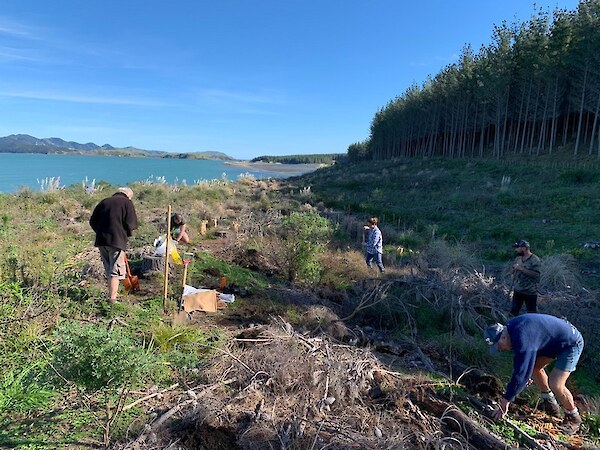 Planting out the trials - Takapuwahia trial site, Kawhia HarbourTe Hiku Forest
Planting out the trials - Takapuwahia trial site, Kawhia HarbourTe Hiku Forest
The initial 2019 trials at Te Hiku were reassessed following the severe drought over summer. Indications from this assessment are that there may be a beneficial effect from the pine shelter although the limited survival rate makes drawing conclusions difficult.
Browse from horses and rabbits/hares was more frequent in the open coast sites compared with the pine gap and canopy sites. Pohutukawa did not show any pressure from browse but there was heavy loss due to low soil moisture.
New trials were established including the planting of 1,550 plants in open, shelter pine gaps and under pine canopy situations evaluating 19 different shrub and tree species. Trials using seed of a few large-seeded plants were also repeated.
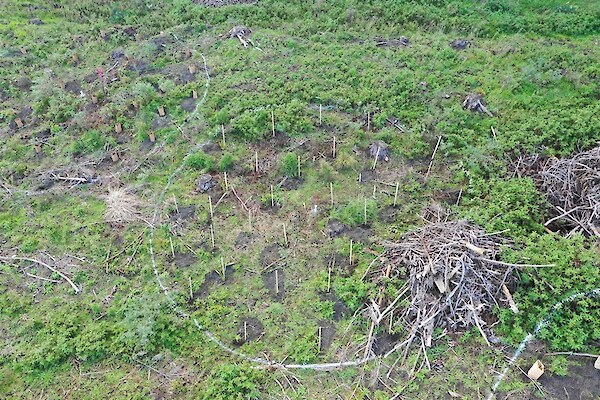 Planted 10m diameter trial plots - Takapuwahia trial site, Kawhia HarbourKawhia Forest
Planted 10m diameter trial plots - Takapuwahia trial site, Kawhia HarbourKawhia Forest
Reassessment of the initial 2019 plant trial found similar plant losses with the extreme summer drought. Another finding from the plastic plant protector treatment (to avoid animal browse) was the unintended consequence of overheating some plants during the summer. There were indications that the natives planted in close proximity to shelter and shade provided by the northern slope of pine trees had higher survival rates. Similarly, there appeared to be higher survival rates for plants where there was extra shelter at a microsite level from slash piles, dead pampas or lupin.
During 2020 a further 4,000 plants were planted, 800 of which were incorporated into the 2019 trial site and the balance in the 2020 Takapuwahia site trials. This site was a relatively flat backdune with slash and scattered regrowth of mostly exotics 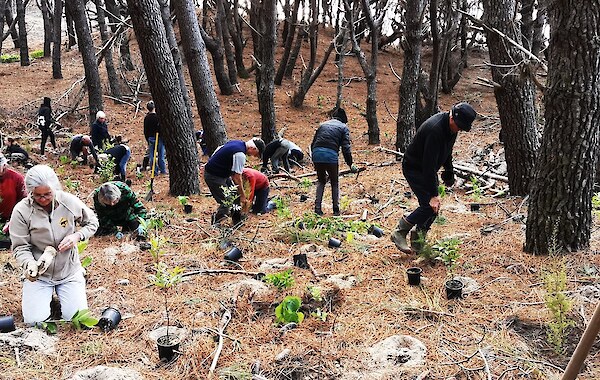 Planting of new trial under forest canopy at Opoutereincluding lupin, inkweed and pampas.
Planting of new trial under forest canopy at Opoutereincluding lupin, inkweed and pampas.
Opoutere forest
Reassessment of the initial 2019 plant trial found the plantings were significantly affected by the extended 2019-2020 drought. Some species were also affected by rabbit browsing. There were clear results for which species could survive planted out in the open and despite the summer drought, e.g. karo, akeake. Results from plants with some shelter from pines showed indications that a few canopy species could establish. However firm conclusions could not be drawn due to the high mortality rate exacerbated by the drought.
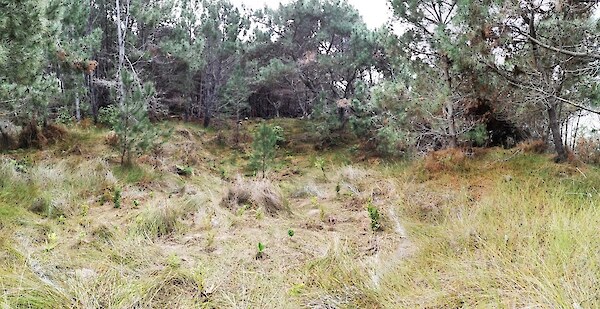 Views of new trial in pine clearing following completion of planting, Opoutere.In 2020 a further 3,455 plants were planted. This included the establishment of new trials under pine canopy and in a clearing surrounded by pine forest. The new trial sites included 9 different tree species.
Views of new trial in pine clearing following completion of planting, Opoutere.In 2020 a further 3,455 plants were planted. This included the establishment of new trials under pine canopy and in a clearing surrounded by pine forest. The new trial sites included 9 different tree species.
Support for this Tāne’s Tree Trust project was gratefully received from project partners including the Sustainable Farming Fund, Summit Forests, Northland Regional Council, Far North iwi, Kaitaia Intermediate, Waikato Regional Council, Kawhia-Tainui Inc, Kawhia community volunteers, Department of Conservation Hauraki, Ngati Tara Tokanui, Opoutere community volunteers, Hancock and the Coastal Restoration Trust.
Coastal buffers planting gets underway - July 2019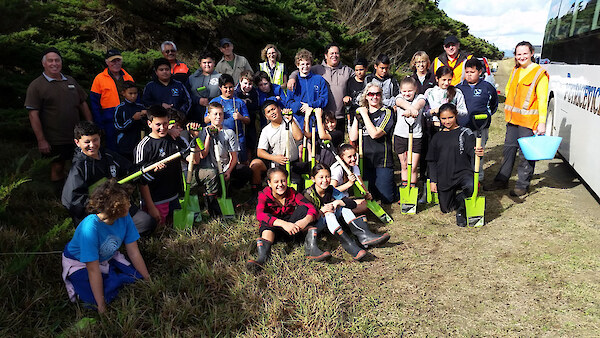 The northern site planting team including Kaitaia Intermediate School, Bushland Trust, NRC and Summit
The northern site planting team including Kaitaia Intermediate School, Bushland Trust, NRC and Summit
Planting has started in the Coastal Buffers project led by Tanes Tree Trust, which the Coastal Restoration Trust is supporting. The project is exploring practical options to transition failing exotic coastal forest margins to resilient permanent buffers made up of native coastal species.
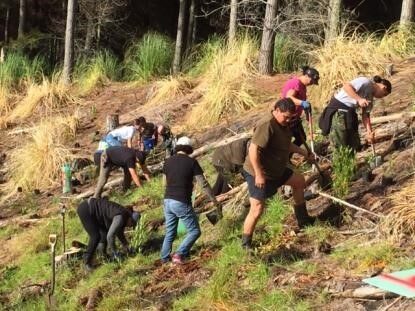 Planting of plots during community planting day Kawhia Forest, WaikatoTo do this, trial sites have been established at Te Hiku (Far North), Kawhia (Waikato) and Opoutere (Coromandel).
Planting of plots during community planting day Kawhia Forest, WaikatoTo do this, trial sites have been established at Te Hiku (Far North), Kawhia (Waikato) and Opoutere (Coromandel).
The plant species selected for the trial plots reflected the range of possible historic coastal forest species at each of the sites but constrained by eco-sourced plant availability. For the exposed open coast plots only a limited selection of hardy primary canopy species was used.
In total over 6,500 plants will be put in the ground this winter by project partners and community volunteers. The survival and growth of these trees will be monitored as part of the project and planting will continue at the three sites next year.
